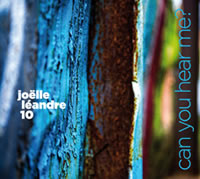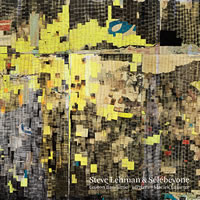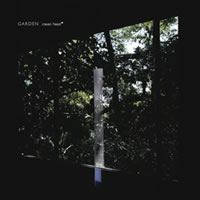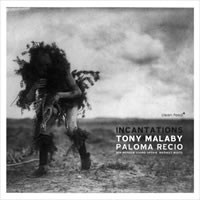Moment's Notice
Reviews of Recent Recordings
(continued)
Joëlle Léandre 10
Can You Hear Me?
Ayler Records AYLCD-146
 Can You Hear Me? is Joëlle Léandre’s nine-part work for a tentet, a rare extended composition by a bassist who has largely worked in improvised settings apart from her collaborations with the composers Giacinto Scelsi and John Cage. This 2015 performance from Metz is the work’s second realization. It was first performed at Ulrichsberger Kaleidophon in 2009 and released as one CD of the two-disc Can You Hear Me & Trio (Leo Records CD/LR 594/595). That version was the subject of an Ezz-thetics column (PoD #34, June 2011) which ends, “Joëlle’s starting to plan to perform the piece again next year, with Kevin Norton again on percussion and a group of French associates. For her, ‘The piece is a kind of mirror, a utopia of musicians’ desires, where different creative possibilities come together.’”
Can You Hear Me? is Joëlle Léandre’s nine-part work for a tentet, a rare extended composition by a bassist who has largely worked in improvised settings apart from her collaborations with the composers Giacinto Scelsi and John Cage. This 2015 performance from Metz is the work’s second realization. It was first performed at Ulrichsberger Kaleidophon in 2009 and released as one CD of the two-disc Can You Hear Me & Trio (Leo Records CD/LR 594/595). That version was the subject of an Ezz-thetics column (PoD #34, June 2011) which ends, “Joëlle’s starting to plan to perform the piece again next year, with Kevin Norton again on percussion and a group of French associates. For her, ‘The piece is a kind of mirror, a utopia of musicians’ desires, where different creative possibilities come together.’”
Clearly it took a little longer and Kevin Norton isn’t on this recording (Florian Satche brings comparable spark), but yes, it is a French ensemble and it’s a heartening example of a major work bridging composition and improvisation that has found renewed life after its initial appearance. Taking nothing away from the original, the present version feels crisper, its contours more sharply defined. There’s a higher level of empathy apparent between Léandre and the French musicians, many of whom she has worked with in other contexts, including the frequent collaborator trumpeter Jean-Luc Cappozzo. Dedicated to Léandre’s parents, it’s edgy work, whether turbulent, tense, exuberant or playful, animated and with a constantly erupting surface. The second movement has moments of great intensity from the intersecting strings of the leader and violinist Théo and cellist Valentin Ceccaldi, the dialogue springing to life in short, gritty bow strokes before Cappozzo’s lyric solo concludes the segment. Others distinguish themselves in solo interludes, the clarinetist Jean-Brice Godet, for example, and the trombonist Christiane Bopp.
While individual inspirations sometimes come to the fore, at other times it’s Léandre’s compositional language, like the Boulez and Messiaen inspirations that characterize the fourth movement, that dominates, suggesting very specific moments in her musical life. That personality is never more important than when she reduces her means to the purest individual expression, her own shamanic aria with bass accompaniment that comes near the conclusion. This is consistently vital work that will engage new listeners and likely those who heard the first realization.
–Stuart Broomer
Steve Lehman + Sélébéyone
Sélébéyone
Pi 66
 Anyone with even a remote interest in Pi’s catalogue over the last decade will have noticed their longstanding interest in hybridity: of genre, instrumentation, even medium. Steve Lehman is an ambitious composer and improviser, who’s documented several aspects of his musical thinking and playing for the label. Sélébéyone is in many ways his most far-reaching project yet. Lehman indicates clearly what his influences in this project are: “Senegalese Rap, French Spectral Music, Modern Jazz, Underground Hip-Hop, Interactive Electronics, and beyond.” That’s an awful lot of music to balance and craft, especially in a tight 36-minute recording like this. But the realization of all these different elements simultaneously is audible right from the start of “Laamb,” whose spacy, spooky electronic settings set the mood.
Anyone with even a remote interest in Pi’s catalogue over the last decade will have noticed their longstanding interest in hybridity: of genre, instrumentation, even medium. Steve Lehman is an ambitious composer and improviser, who’s documented several aspects of his musical thinking and playing for the label. Sélébéyone is in many ways his most far-reaching project yet. Lehman indicates clearly what his influences in this project are: “Senegalese Rap, French Spectral Music, Modern Jazz, Underground Hip-Hop, Interactive Electronics, and beyond.” That’s an awful lot of music to balance and craft, especially in a tight 36-minute recording like this. But the realization of all these different elements simultaneously is audible right from the start of “Laamb,” whose spacy, spooky electronic settings set the mood.
Throughout the record, it’s the cadence of speech that is the basis for a lot (though not all) of the instrumentalism and the compositional language to boot. This is consistent with a lot of what’s compelled Lehman as an improviser in the past: that merging of pulse, phrasing, and density of rhythm and line. And it works absolutely marvelously in these pieces whose production is carefully considered and constructed as on many state-of-the-art hip-hop records. It’s got intensity that comes from old analog dirt and haze on some tracks, and sounds like futuristic blown glass elsewhere. But it’s not just Lehman’s own distinctive saxophonism that’s key to this realization, despite how powerful are his angular, tone-bending, idiosyncratic lines both askew from and perfectly at home in the rhythms. Soprano specialist Maciek Lasserre is credited with composition, and that’s before we even get to the Drew Gress/Damion Reid rhythm team, the essential contributions of keyboardist Carlos Homs, and rappers Bamar Ndoye and HPrizm.
It’s almost impossible not to fall for the contrast between French African and English rhymes (HPrizm is confident and smooth next to Ndoye’s intense, at times prophetic cadence), especially in this thick brew of jittery, spidery rhythms from piano, bass, and drums, a multiform staggered beat matrix. And on each track there are tons of layers, like the soundtrack of a city racing by. The contrast between the marvelously disorienting texture that opens “Akap” and the stentorian rap at its heart is punchy and delicious. “Origine” is a floating world of dark sonorities (“without space, without time ... “) and almost yearning sax lines swathed in deep resonant delay; but that’s only until – contrast once more – another choppy, energizing vocal rave-up backed by scorching sax. While there are places of lambent cool or low flame, most of the time it’s infectious bordering on overwhelming in its density of information: the interactive electronics and insane range of Carlos Homs’ keyboards combine so intensely with Gress and Reid. Reid in particular is just outrageous in his interaction with vocals and sax, perhaps nowhere better than on “Hybrid” (and it’s worth noting just how damn good Lehman and Lasserre are at coming up with very distinctive settings for each of the vocalists). The spacy, fractal sound on “Dualism” impresses in its embrace of electronics as electronics, with no cheap attempts at instrumental mimicry. Hear this best of all on “Bamba,” which opens with suggestive, vaguely disorienting vocal samples, only to set you up to be buffeted madly by skittering electronics gone haywire and multiple voices spooling out together and apart at once. Overall, it’s a madcap, whirlwind record, whose ambition is matched and then some.
–Jason Bivins
Luís Lopes
Love Song
Shhpuma SHH025LP
Parrinha + Lopes + Jacinto
Garden
Clean Feed CF369CD

 Guitarist Luís Lopes is a distinguished figure in the vigorous Lisbon free jazz/improvised music scene. His work covers a broad spectrum that begins with his Humanization 4tet, a hard driving free band with saxophonist Rodrigo Amado and the rhythm section of Texan brothers Aaron and Stefan Gonzalez on bass and drums respectively, a band that has twice toured America, and continues with the similarly energetic Lisbon-Berlin Trio with bassist Robert Landfermann and drummer Christian Lillinger. His approach to sonic improvisation is evident in his duo with French saxophonist Jean-Luc Guionnet and on the literally titled Noise Solo LP. Other dimensions of Lopes’ expansive vision appear in the recent CD by the trio Parrinha/Lopes/Jacinto and the solo LP Love Song.
Guitarist Luís Lopes is a distinguished figure in the vigorous Lisbon free jazz/improvised music scene. His work covers a broad spectrum that begins with his Humanization 4tet, a hard driving free band with saxophonist Rodrigo Amado and the rhythm section of Texan brothers Aaron and Stefan Gonzalez on bass and drums respectively, a band that has twice toured America, and continues with the similarly energetic Lisbon-Berlin Trio with bassist Robert Landfermann and drummer Christian Lillinger. His approach to sonic improvisation is evident in his duo with French saxophonist Jean-Luc Guionnet and on the literally titled Noise Solo LP. Other dimensions of Lopes’ expansive vision appear in the recent CD by the trio Parrinha/Lopes/Jacinto and the solo LP Love Song.
Lopes plays his customary electric guitar as a prepared lap instrument in the collective trio with José Bruno Parrinha on clarinet and alto and soprano saxophones and Ricardo Jacinto on cello and electronics, and it’s a key to a certain abstraction the trio practices, a shift from the sheer physicality of much of Lopes’ music. The seven tracks are simply numbered: the sole verbal content the trio affixes to its music is that name Garden, but it may say everything. It’s largely textured or timbral music, each episode a series of evolving layers that at times seem linked principally by their simultaneity, even while identity is sublimated in the music; at other times, the levels of intensity and responsive detail are startling. While the focus is sonic, the music is often constructed on scraps of minimal melody, an elemental phrase, a kind of emblem, that’s repeated. ln “1,” a piece of sustained beauty that insists on the garden metaphor (a range of vision over shifting textures and ground and changing patterns of light and shade), melodic repetition and drone fuse to create a kind of raga. While “5” is a sustained episode of electronic grit, “4” stands out for Parrinha’s expressionist alto explosion. That diversion is ultimately drawn into the larger theme when the saxophone line is echoed by the others, as if a bramble has suddenly caught sunlight and cast its shadow on another species. Gradual shifts are a characteristic here, especially on the extended pieces, whether it’s a line from reflection to dense turbulence (“1”) or the opposite (“2”). “6” moves from a certain tense randomness to unison, while “7” is pointillist scattershot. Whatever the details of a piece, there’s a strong sense of attention that links these pieces, a continuing involvement that encourages close listening.
Love Song is in sharp contrast to the feedback-driven Noise Solo and the subtle electronic dimensions of Garden. It’s a late night reflection on the feelings and events of a relationship, played with an almost naked electric guitar sound most notable for its sustained tones and clarity. The very involvement in the guitar is one with the delineation of mood, the simplest slow arpeggio hanging in the air, the subtle mutation from chord to cluster, the gradual elaboration of dissonance in “Evil’s Face,” the absolute brevity of “The Beauty of Love.” It’s deeply personal, deeply felt, intimate music making, but as one might try to describe its depths, the language of music’s mechanics takes over. Every descriptive term, quantitative or qualitative, assumes emotional resonance as one focuses on Lopes’ attention to attack and decay (the sharp attacks and long decays of “Ever Eternal Loneliness,” for example), envelope and sustain, inflections of pitch and time, the back and forth movements between consonance and dissonance. Lopes’ decision to release his solo music on vinyl gives it an absolute presence, shifts in resonance, incidental fingerboard noises and gradations in tone settings contributing to the music’s meaning.
–Stuart Broomer
Tony Malaby Paloma Recio
Incantations
Clean Feed CF367CD
 Tony Malaby has become one of the most distinctive saxophonists on the international scene since emerging from his hometown of Tucson, Arizona nearly two decades ago. Although Malaby currently leads a handful of instrumentally unique small combos – including Novela, Tamarindo, and Tubacello – it is with Paloma Recio (Loud Dove) that the first generation Mexican-American delves deepest into his heritage, abstracting Iberian-tinged melodies with the support of guitarist Ben Monder, bassist Eivind Opsvik and drummer Nasheet Waits.
Tony Malaby has become one of the most distinctive saxophonists on the international scene since emerging from his hometown of Tucson, Arizona nearly two decades ago. Although Malaby currently leads a handful of instrumentally unique small combos – including Novela, Tamarindo, and Tubacello – it is with Paloma Recio (Loud Dove) that the first generation Mexican-American delves deepest into his heritage, abstracting Iberian-tinged melodies with the support of guitarist Ben Monder, bassist Eivind Opsvik and drummer Nasheet Waits.
Incantations is Paloma Recio’s sophomore effort, following its self-titled 2009 debut for New World Records. The titular four-part suite is a wholly democratic ensemble effort. “Glass” opens the proceedings tentatively, with bowed bass and scintillating guitar harmonics setting the stage for the leader’s sinuous soprano, which leads the ensemble on a collective expedition from tranquility to turmoil. The angular swinger “Artifact” follows, its infectiously jagged cadence recalling none other than Thelonious Monk’s “Trinkle, Tinkle.” “Hive” builds incrementally in intensity from unaccompanied soprano musings to a full-band improvisation, but it is the closer, “Procedure,” that is the album’s conceptual and climactic centerpiece. In just under a third of an hour, the epic finale follows an inexorable arc; Opsvik establishes the theme alone, with the rest of the band joining gradually. Ebbing and flowing from hushed rhythm section interplay to a cathartic drum and tenor duet, the piece concludes with Malaby and Monder at their most unrestrained.
Malaby is a broadly expressive soloist with an ear for structural dynamics; he accentuates idiosyncratic phrases with virtuosic embouchure control, expanding conventional tonality with a texturally rich harmonic palette. Often dovetailing with Malaby’s thorny cadences, Monder makes a perfect foil; whether eliciting shimmering cascades, kaleidoscopic arpeggios or searing sustain, his understated attack and variable tone meshes seamlessly with the saxophonist’s breathy ruminations. Opsvik and Waits demonstrate their congenial rapport with dynamic versatility at every turn, bringing Malaby’s sketches to life with rhythmic invention and colorful accents.
A visceral exploration of the basic foundations of melody, harmony, and rhythm, Incantations is another compelling recording in the growing discography of one of today’s preeminent saxophonists.
–Troy Collins
Tony Marsh + Chefa Alonso
Good Bye Red Rose
Emanem 5043
 There are many musicians like English drummer Tony Marsh (1939-2012) and Spanish saxophonist Chefa Alonso (b. 1955), journeying musicians who haven’t attracted wider attention within the world of jazz and creative improvisation, but who nevertheless pay their dues, take their work incredibly seriously, and presumably have had loads of fun while doing it. Marsh was an integral part of the London scene, if less visible elsewhere, though those with a more voracious appetite for improvisation on disc are well-acquainted with his work with trumpeter Harry Beckett, pianists Mike Westbrook and Howard Riley, and reedists Frode Gjerstad, Paul Dunmall, Roscoe Mitchell and George Haslam – just to name a few. Alonso has recorded less – she was a member of the London Improvisers Orchestra while in England – but a slim discography doesn’t diminish the quality of her nattering, spiraling lines and skirls on soprano.
There are many musicians like English drummer Tony Marsh (1939-2012) and Spanish saxophonist Chefa Alonso (b. 1955), journeying musicians who haven’t attracted wider attention within the world of jazz and creative improvisation, but who nevertheless pay their dues, take their work incredibly seriously, and presumably have had loads of fun while doing it. Marsh was an integral part of the London scene, if less visible elsewhere, though those with a more voracious appetite for improvisation on disc are well-acquainted with his work with trumpeter Harry Beckett, pianists Mike Westbrook and Howard Riley, and reedists Frode Gjerstad, Paul Dunmall, Roscoe Mitchell and George Haslam – just to name a few. Alonso has recorded less – she was a member of the London Improvisers Orchestra while in England – but a slim discography doesn’t diminish the quality of her nattering, spiraling lines and skirls on soprano.
Good Bye Red Rose consists of six improvisations of the Marsh-Alonso duo as it existed in 2008 and 2009, closing out the performance series at the titular, beloved and departed London club, as well as cuts taken from Ryan’s Bar in London (by name, probably not a far cry from many of the great improvised music gigs one encounters in Brooklyn) and the Matadero, a contemporary arts center in Madrid. The latter, represented by the fifteen-minute “Huesca,” finds the soprano saxophonist in command of dry, quacky overlaps and metallic breaks fueled by Marsh’s bright and generally laid-back, yet tough coil. Her fiery, drilling verticality has the bone-worrying obsessiveness of a Roscoe Mitchell or Lol Coxhill, with Lacy-ish winsome sputter, and the contrast with Marsh’s ultra-loose, shimmering crumples and yoked stutter is remarkable. The opening title cut is a pattern of brushy fireworks and spare webs of skin, metal, wood and breath in a constant, relaxed match, followed by the arid, rumbling snap of “By the Hand.” In each piece, the pair engage in a dance of complementary opposites — the impossibly relaxed exactitude of Marsh’s gentle gifts are met with furrowed handiwork and weird vocal asides – yet the results couldn’t be more together. With minimal means and in casual settings, Tony Marsh and Chefa Alonso created some truly extraordinary free music.
–Clifford Allen